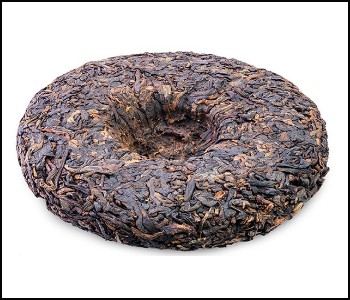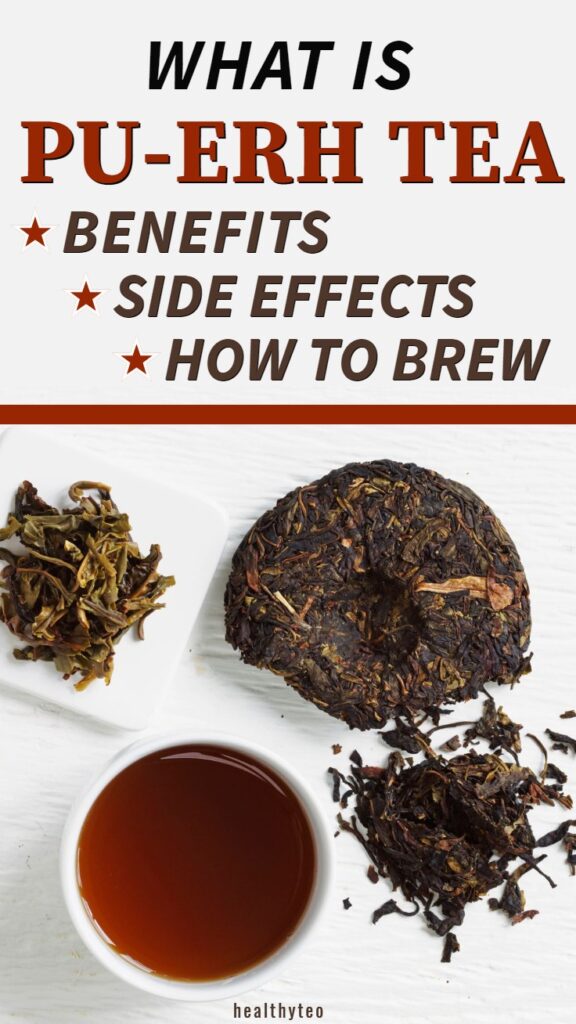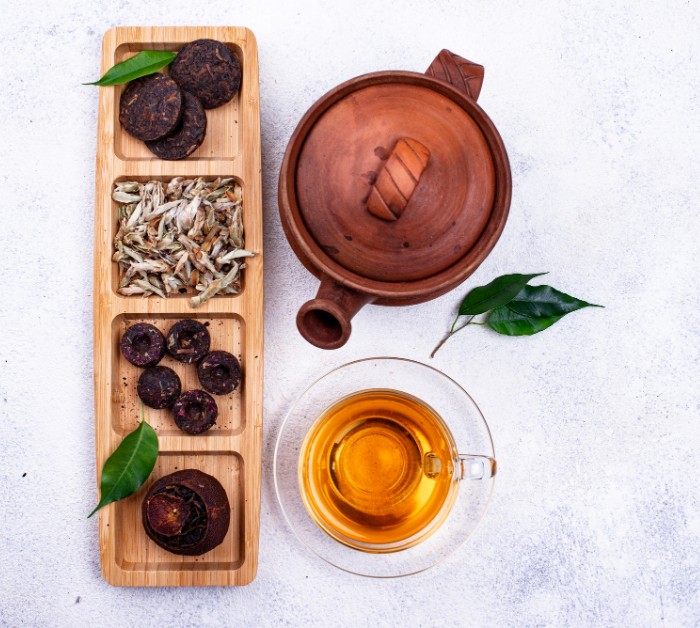Benefits and side effects of drinking Pu-erh tea
What do you know about Pu-erh tea? Is this China’s best-kept secret for weight loss or there is more?
You are at the right place if you want to find out more about the benefits of Pu-erh tea. And not just that, we’ve covered in this article also the side effects and how to brew this delicious and healthy tea named Pu-erh.
This post may contain affiliate links, which means we may receive a small commission, at no cost to you, if you make a purchase through a link. For more information, please see our disclosure.
What is Pu-Erh tea?
Pu-erh tea pronounced as poo-air, comes from the same plant such as green, white, and oolong teas – Camellia sinensis plant.
Named for a city in China’s Yunnan region and primarily produced in that region, Pu-erh tea is the most oxidized form of tea, often aged and sometimes very expensive.
The distinct flavor of Pu-erh’s comes from the fact that after the leaves are picked they are made into a sundried base tea called maocha (tea that has undergone processing but is not ready for retail sale yet) and then fermented.
The tea leaves undergo a two-part fermentation process. This fermentation process allows beneficial bacteria and fungal bacteria to develop, resulting in the tea’s health benefits.
Once the tea is fermented leaves are sundried and aged in a high-humidity environment (sometimes for years or even decades), and finally they are packed into bricks or cakes.
For brewing, pieces are separated from these cakes and then brewed according to the quantity needed.
A cake of Pu-erh tea is disc-shaped and flat.
The size can range from 100 grams to 5kg. In general, a cake size of 300-500 grams is most common.

Interesting To Know
Unlike other teas that get stale over time, Pu-erh can mellow and improve with age. Some Pu-erh teas are sold for thousands of dollars in special Asian stores, and they can be more than 50 years old.
There are two types of Pu-erh tea – raw (sheng) and ripe (shou).
- Raw Pu-erh tea is made from non-fermented green tea leaves that are picked, quickly roasted, sun-dried, and then steamed to be compressed into cakes. The cakes’ are aged until the tea’s taste appropriately transformed.
- Ripe Pu-erh is made from black tea (oxidized). After going through the same process as raw Pu-erh, ripe Pu-erh undergoes a special procedure called “wet-pilling”. During this process, special bacteria are added to further ferment the leaves.
Interesting Fact
Raw Pu-erh tea is with over 800 years of history, while ripe Pu-erh is a relatively new type. This technique of making ripe Pu-erh was developed by tea farmers in the 1970s.
Pu-Erh tea benefits for skin, weight loss, cholesterol, and more
Almost every type of tea including regular Black Tea is rich in vitamins, minerals, and other antioxidants, due to its processing Pu-erh tea tends to have more of these compounds.
Why Pu-erh tea is good for you? – The constituents found in it include arginine, caffeine, calcium, magnesium, iron, vitamin B-1, B-2, Vitamin C, zinc…
It contains only 2 calories per 8-oz serving which makes it an excellent weight-loss tool. Here is the list of the main benefits of Pu-erh tea.
May promote weight and fat loss
The most popular reason why people in Asia drink Pu-erh tea is weight loss. There is little evidence that supports the use of Pu-erh tea for weight loss, but some animal and test-tube studies have shown that Pu-erh can help synthesize fewer new fats while burning more stored body fat.
The main bioactive components, such as theabrownin (TB), polysaccharides, polyphenols, and statins, may down-regulate the biosynthesis of fat and up-regulate the oxidation of fat to cut weight and reduce the content of lipids in the blood.
These are animal studies, more human studies are needed to verify the weight loss properties of Pu-erh tea.
In a study from 2011 published by NIH where was investigated the effect of water-soluble Pu-erh tea extract on 36 preobese Japanese adults was found that 333 mg of Pu-erh tea extract 3 times a day for 12 weeks results in significantly improved body weight and body mass index (BMI) compared with a controlled group.
We must mention that this research was not about drinking Pu-erh tea it was about Pu-erh tea extract which contained the active ingredients of Pu-erh tea n much higher doses.
Digestive aid
Pu-erh also helps with the digestion of fats and lipids. This is another reason for the weight loss properties of this tea. Not just that, fermented teas like Pu-erh contain as we mentioned above polysaccharides, naturally occurring sugars that promote healthy microbial communities.
These bacteria play an important role in maintaining the general health of the digestive system.
Again these are all animal studies, further studies are needed to determine the properties of Pu-erh tea on weight loss.
Protecting against free radicals
Another benefit of drinking Pu-erh tea is that is rich in antioxidants that are protecting cells against free radical damage. The oxidative properties of Pu-erh tea help to increase the oxygen levels which enhance blood flow and circulation.
By delivering more oxygen to the brain this tea can help combat migraines and headaches and reduce free radicals that can cause serious health issues.
In Chinese medicine, Pu-erh tea is used to aid the spleen and stomach in filtering toxins throughout the body. Sugar and microorganisms present in Pu-erh help the spleen to clean the blood and eliminate free radicals.
Reducing cholesterol
In a study published in 2016 where was evaluated the effects of daily consumption of Pu-erh tea extract on body weight, body-fat composition, and lipid profile in a non-Asian population in the absence of dietary restrictions, was determined that Pu-erh may help keep cholesterol in check.
Other Chinese study shows that Pu-erh tea can help to reduce bad cholesterol and prevent obesity-related diseases. Again this is an animal study conducted on rats. This study used Pu-erh tea on rats with high-fat diets over an eight-week period.
The results showed that rats that received Pu-erh tea had lower triglyceride and cholesterol levels, and at the same time Pu-erh increased good cholesterol known as HDL. Higher HDL levels are associated with a lower risk of heart disease.
Increases energy
Pu-erh tea belongs to the category of caffeinated teas, it contains caffeine. Every 8-ounce cup of Pu-erh tea contains 60 to 70 milligrams of caffeine, compared to 105 milligrams in a standard cup of coffee.
Drinking a cup a day can help you to increase energy levels and focus. This is also a great caffeinated drink for people who find themselves jittery after just one cup of coffee.
Read more: Best Tea Alternatives To Your Morning Coffee
Reduces stress
In this list of Pu-erh tea benefits, we must mention its stress relief properties. Phyto-chemicals GABA and theanine present in Pu-erh tea, are associated with lowering stress levels.
These phytochemicals increase the production of melatonin, which can aid in better sleep and a calmer demeanor throughout the day.
Skin health
Free radicals are bad for overall health and also for skin health. Skin damage due to free radicals can appear sometimes visible and sometimes not. Your skin may look wrinkled as the free radicals lead to the breakdown of skin collagen.
Antioxidants for healthier skin
Pu-erh tea is rich in antioxidants and these antioxidants act as the treatment for free radicals and prevent skin damage. A cup of Pu-erh tea daily can help your skin maintain its charm and look healthier.
Antibacterial properties for acne
Another benefit of drinking Pu-erh tea daily for your skin, its antibacterial properties help prevent bacterial infections and other skin conditions such as acne formation.
The main reason behind acne formation is dead skin, blocked pores, and bacteria. Consuming Pu-erh tea can help with this skin condition.
Anti-aging
Photoaging occurs when your skin is exposed to ultraviolet radiation (UV), signs of photoaging include spider veins that appear on the most visible parts of the face and body such as the nose, cheeks, neck, and hands.
Regular consumption of Pu-erh tea exfoliates and moisturizes the skin to a large extent.
Potential side effects
Drinking Pu-erh tea is safe for most healthy adults in moderate amounts, about 4 cups per day. Drinking large amounts (more than 4 cups per day) might cause some side effects due to its caffeine content.
These side effects of drinking too much Pu-erh tea include headache, nervousness, irregular heartbeat, insomnia, dizziness, irritability.
Dizziness: Drinking strong Pu-erh or overdrinking may result in dizziness, and people with low blood sugar or low blood pressure can’t have it on an empty stomach.
Teeth stain: If you drink too much the pigment from fermented Pu-erh will stay on your teeth.
Anemia: Females in their periods should keep away from it, otherwise, tannin will react with the iron element in brewed tea, resulting in the blood-making system operates slower.
Pregnancy and breastfeeding: When pregnant or breastfeeding drinking Pu-erh tea is possibly safe in amounts of 3 cups or less daily. This amount is equal to 300 mg of caffeine. High intake of caffeine by nursing mothers can cause sleep disturbance, irritability, and increased bowel activity in breast-fed infants.
When it comes to the side effects of drinking Pu-erh tea we must mention that the fermentation process can produce mycotoxins – toxic compounds produced by some fungi, along with possible bacterial toxins.
You shouldn’t worry about this, studies show that these mycotoxins detected in Pu-erh tea are at low levels and are considered safe. But it is good to keep in mind and rinse your tea before doing a full brew.
Also, like all fermented foods that are rich in bacteria, Pu-erh tea is also rich in bacteria that have the potential to change your digestion or even mess with your stomach until your system has some time to adjust.
Good To Know
Most of the side effects of Pu-erh tea come from its caffeine content. Pu-erh tea can contain 30-100 mg of caffeine per cup, depending on the strength of the brew. Most people tolerate up to 400 mg of caffeine daily.
How to brew Pu-erh tea
Now when you know the benefits and side effects of Pu-erh tea it is time to make a delicious and healthy cup of tea.
Here are the instructions for making Pu-erh tea:
It is your choice to use leaf Pu-erh or a Pu-erh cake, no matter what you chose it is recommended to use approximately 3-4 grams of Pu-erh tea per 200 ml of water.
If you decide to use Pu-erh cake break off a small piece and weigh the tea to ensure that you have the right amount for the quantity of tea you wish to brew. For this purpose, you can use a tea scoop.
Place the tea in an infuser, secure the infuser in your teapot, and pour in a small amount of water. The hotter the temperature of the water the stronger your brew will be.
Swirl the water around to clean any impurities of the tea and discard it leaving the wet leaves of tea in your infuser.
Pour the hot water into your teapot and leave it steep for 2-4 minutes.
When the steep time is over remove your tea filter to stop the infusion. You can reuse the tea several times.
In the final step, there is the option of adding milk or sugar. Most, however, serve it black. Enjoy your delicious cup of Pu-erh tea.
Frequently asked questions (FAQ)
Pu-erh tea cake or brick will last you for many months or years. It is important to not break it up by hand. Use some sort of a needle to find the softest spot before carefully wiggling pieces loose.
You can reuse tea leaves several times, just keep in mind that the infusion they create will taste slightly different every time.
Put it in a place where there is no sunlight but cool and ventilated. Don’t store near strong odors, the leaves can absorb strong odors that that waft through the air nearby.
The steeping time of Pu-erh tea is 2 to 4 minutes. You can steep for two minutes and taste every 30 seconds to find your preferred flavor.
The caffeine levels in Pu-erh tea will be somewhere between 30 and 100 mg per cup of 8 oz (235ml), compared to caffeine in coffee which is 60 to 95 mg per cup. The brewing methods have a big impact on the caffeine content of the resulting beverage.

Final thoughts about the Pu-erh tea and why it is good for you
If you want to reduce coffee intake and still get some caffeine Pu-erh tea is the right choice. The list of benefits of Pu-erh tea is long as we mentioned it is good for weight loss, reducing cholesterol, increasing energy, it can improve your heart health, improve digestion…
Even it is good for you, if you have any health issues that are related to the side effects of drinking Pu-erh tea it is recommended to consult with your doctor first before adding Pu-erh tea into your daily tea list.
Try this healthy and delicious beverage today. You can enjoy its taste in the morning, afternoon and be careful in the evenings, as we mentioned it is caffeinated tea.




